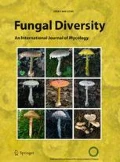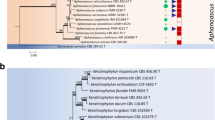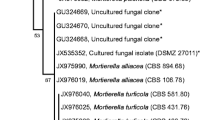Abstract
Isolations of onygenalean fungi were made recently from different dung samples from Italy. A striking snow-white species with gymnothecial ascomata, developed in damp chamber on dormouse dung collected in a cave, was subjected to keratinolytic tests and morphological, cultural, and phylogenetic studies. The keratinolytic ability of this species, associated with a Chrysosporium anamorph and a sexual state of appendiculate reticuloperidia and oblate ascospores, allows it to be accomodated in Onygenaceae. White ascomata, blunt or subcapitate peridial appendages, pitted ascospores, and tuberculate conidia suggest it to be a new Neogymnomyces, and this was confirmed by parsimony analyses of LSU and ITS nrDNA sequences. Following recent phylogenetic analyses, the morphological and physiological features of order Onygenales and its families are re–examined and discussed. After the introduction of a new species, Neogymnomyces is reviewed and compared with all other genera in Onygenaceae. The Chrysosporium imperfect state of Neogymnomyces virgineus is described and compared to the anamorph of N. demonbreunii. It is also compared to the atypical Chrysosporium merdarium and to several other Chrysosporium species with echinulate to verrucose–tuberculate conidia, isolated from guano, dung, and nitrogen–rich soils in caves. The onygenalean fungi isolated from any kind of dung are discussed and their facultative coprophily ascribed to variable faecal contents of keratin or other degradable substances. A key to the families and genera of the Onygenales is provided.









Similar content being viewed by others
References
Ajello L, Cheng S-L (1967) Sexual reproduction in histoplasma capsulatum. Mycologia 59:689–697. doi:10.2307/3757097
Ajello L, Varsavsky E, Sotgiu G, Mazzoni A, Mantovani A (1965) Survey of soils for human pathogenic fungi from the Emilia–Romagna region of Italy. Mycopathology 26:65–71
Ajello L, Kuttin ES, Beemer AM, Kaplan W, Padhye A (1977) Occurrence of histoplasma capsulatum darling, 1906 in Israel, with a review of the current status of histoplasmosis in the Middle East. Am J Trop Med Hyg 26:140–147
Apinis AE (1964) Revision of British gymnoascaceae. Mycol Pap 96:1–56
von Arx JA (1971) On arachniotus and related genera of the gymnoascaceae. Persoonia 6:372–380
von Arx JA (1977) Notes on gymnoascaceae. Persoonia 9:393–400
von Arx JA (1987) A re–evaluation of the eurotiales. Persoonia 13:273–300
von Arx JA, Samson RA (1986) Mallochia, a new genus of the eurotiales. Persoonia 13:185–188
Balabanoff VA (1967) Etudes comparées des dermatophytes isolés de grottes et d’étables en Bulgarie. Mycopathology 32:237–248
Baranetzky J (1872) Entwickelungsgeschichte des Gymnoascus reessii. Bot Ztg 30:155–160
Blyskal B (2009) Fungi utilizing keratinous substrates. Int Biodeterior Biodegrad 63:631–653. doi:10.1016/j.ibiod.2009.02.006
Bowman BH, White TJ, Taylor JW (1996) Human pathogenetic fungi and their close nonpathogenic relatives. Mol Phyl Evol 6:89–96. doi:10.1006/mpev.1996.0061
Cain RF (1957) Studies of coprophilous Ascomycetes—VI. Species from the Hudson Bay area. Can J Bot 35:255–265. doi:10.1139/b57-022
Cannon PF, Kirk PM (2007) Fungal families of the world. CABI, Egham
Cano J, Guarro J (1990) The genus aphanoascus. Mycol Res 94:355–377. doi:10.1016/S0953-7562(09)80361-4
Cano J, Guarro J, Castañeda Ruiz RF (1994) Studies on keratinophilic fungi. IV. Bifidocarpus, a new genus of the Eurotiales. Mycotaxon 52:53–57
Cano J, Ulfig K, Guillamon JM, Vidal P, Guarro J (1997) Studies on keratinophilic fungi. IX: Neoarachnotheca gen. nov. and a new species of Nannizziopsis. Antonie Van Leeuwenhoek 72:149–158. doi:10.1023/A:1000394118040
Cano J, Sagués M, Barrio E, Vidal P, Castañeda RF, Gené J, Guarro J (2002a) Molecular taxonomy of Aphanoascus and description of two new species from soil. Stud Mycol 47:153–164
Cano J, Solé M, Pitarch LB, Guarro J (2002b) Castanedomyces australiensis, gen. nov., sp. nov., a keratinophilic fungus from Australian soil. Stud Mycol 47:165–172
Cano J, Solé M, Pitarch LB, Guarro J (2002c) Pseudoamauroascus, a new genus of the Onygenales (Ascomycota). Stud Mycol 47:173–179
Caretta G, Mangiarotti AM, Piontelli E (1992) Keratinophilic fungi isolated from soil of Italian parks in the province of Pavia. Eur J Epidemiol 8:330–339. doi:10.1007/BF00158564
Carmichael JW (1962) Chrysosporium and some other aleuriosporic Hyphomycetes. Can j Bot 40:1137–1173. doi:10.1139/b62-104
Cugnani HC (2000) Nondermatophytic filamentous keratinophilic fungi and their role in human infection. Rev Iberoam Micol: 109–114
Currah RS (1985) Taxonomy of the onygenales: arthrodermaceae, gymnoascaceae, myxotrichaceae and onygenaceae. Mycotaxon 24:1–216
Currah RS, Abbott SP, Sigler L (1996) Arthroderma silverae sp. nov. and chrysosporium vallenarense, keratinophilic fungi from arctic and montane habitats. Mycol Res 100:195–198. doi:10.1016/S0953-7562(96)80121-3
Dade HA (1957) Coprophilous fungi. J Quekett Microsc Club 4:396–406, ser. 4
Doveri F (2004) Fungi Fimicoli Italici. A.M.B.–Fondazione Studi Micologici, Vicenza
Doveri F (2006) Nuove segnalazioni di Onygenales coprofile dall’Italia. New records of coprophilous onygenales from Italy. Riv Micol 49:245–266
Elshafie AE (2005) Coprophilous mycobiota of Oman. Mycotaxon 93:355–357
Evolceanu R, Alteraş I (1967) Eine keratinophile Chrysosporium–Art mit ausgesprochen dermatophytischen, immunbiologischen Eigenschaften aus Guano von einer Grotte in Rumänien (unvollkommenes Stadium von Arthroderma multifidum—Dawson 1963?). Mykosen 10:489–492
Felsenstein J (1985) Confidence limits on phylogenies: an approach using the bootstrap. Evolution 39:783–791. doi:10.2307/2408678
Filipello Marchisio V (1986) Keratinolytic and keratinophilic fungi of children’s sandpits in the city of Turin. Mycopathology 94:163–172. doi:10.1007/BF00454595
Filipello Marchisio V (2000) Keratinophilic fungi: their role in nature and degradation of keratinic substrates. In: Kushwaha RKS, Guarro J (eds) Biology of dermatophytes and other keratinophilic fungi. Rev Iberoam Micol, Bilbao, pp 86–92
Gams W, Hoekstra ES, Aptroot A (1998) CBS course of mycology. In: Gams W, Hoekstra ES, Aptroot A (eds) Ponsen and Looyen BV, Wageningen, pp 1–165
Garrison RG, Mirikitani FK (1983) Fine structural studies of the Chrysosporium state of Renispora flavissima. Mycopathology 81:3–7. doi:10.1007/BF00443903
Gräser Y, Kuijpers AFA, Presber W, de Hoog GS (2000) Molecular taxonomy of the Trichophyton rubrum complex. J Clin Microbiol 38:3329–3336
Guarro J, Punsola L, Calvo MA (1981) Keratinophilic fungi from soil of Tarragona, Catalunya. Mycopathology 76:69–71. doi:10.1007/BF00443752
Guarro J, Punsola L, Cano J (1987) Byssoonygena ceratinophila, gen. et sp. nov. a new keratinophilic fungus from Spain. Mycopathology 100:159–161. doi:10.1007/BF00437042
Guarro J, Cano J, de Vroey Ch (1991) Nannizziopsis (Ascomycotina) and related genera. Mycotaxon 42:193–200
Guarro J, Summerbell RC, Samson RA (2002) Onygenales: the dermatophytes, dimorphic and keratin degraders in their evolutionary context. Stud Mycol 47:1–220
Hassouna N, Michot B, Bachellerie JB (1984) The complete nucleotide sequence of mouse 28S rRNA gene: implications for the process of size increases of the large subunit rRNA in higher eukaryotes. Nucleic Acids Res 12:3563–3583. doi:10.1093/nar/12.8.3563
Henry T, Iwen PC, Hinrichs SH (2000) Identification of Aspergillus species using internal transcribed spacer regions 1 and 2. J Clin Microbiol 38:1510–1515
Herr RA, Taracha EJ, Taborda PR, Taylor JW, Ajello L, Mendoza L (2001) Phylogenetic analysis of Lacazia loboi places this previously uncharacterized pathogen within the dimorphic Onygenales. J Clin Microbiol 39:309–314. doi:10.1128/JCM.39.1.309-314.2001
de Hoog GS, Guarro J, Gené J, Figueras MJ (2000) Atlas of clinical fungi, 2nd edn. Centraalbureau voor Schimmelcultures, Utrecht
Howard DH (2002) Pathogenic fungi in humans and animals, 2ath edn. Marcel Dekker, New York
Iwen PC, Sigler L, Tarantolo S, Sutton DA, Rinaldi MG, Lackner RP, McCarthy DI, Hinrichs SH (2000) Pulmonary infection caused by Gymnascella hyalinispora in a patient with acute myelogenous leukemia. J Clin Microbiol 38:375–381
Katoh K, Toh H (2008) Recent developments in the MAFFT multiple sequence alignment program. Brief Bioinform 9:286–298. doi:10.1093/bib/bbn013
Kirk PM, Cannon PF, Minter DW, Stalpers JA (2008) Dictionary of the fungi, 10th edn. CABI Europe, UK
Komada H (1975) Development of a selective medium for quantitative isolation of Fusarium oxysporum from natural soil. Rev Plant Prot Res 8:114–125
Kuehn HH (1959) A preliminary survey of the Gymnoascaceae. II. Mycologia 51:665–692. doi:10.2307/3755896
Kuehn HH, Orr GF (1959) Observations on Gymnoascaceae. VI. A new species of Arachniotus. Mycologia 51:864–870. doi:10.2307/3755837
Kwon-Chung KJ (1968) Gymnoascus demonbreunii Ajello and Cheng: evidence that it is not the perfect state of Histoplasma capsulatum Darling. Sabouraudia 6:168–175
Landvik S, Shailer NFJ, Eriksson OE (1996) SSU rDNA sequence support for a close relationship between the Elaphomycetales and the Eurotiales and Onygenales. Mycoscience 37:237–241. doi:10.1007/BF02461292
Larcher G, Bouchara JP, Pailley P, Montfort D, Beguin H, De Bièvre C, Chabasse D (2003) Fungal biota associated with bats in western France. J Mycol Méd 13:29–34
Lumbsch HT, Huhndorf SM (2007) Outline of ascomycota—2007. Myconet 13:1–58
Lumley TC, Currah RS (1995) A preliminary account of some unusual onygenalean fungi from decayed wood. Rep Tottori Mycol Inst 33:7–13
Makimura K, Mochizuki T, Hasegawa A, Uchida K, Saito H, Yamagishi H (1998) Phylogenetic classification of Trichophyton mentagrophytes complex strain based on DNA sequences of nuclear ribosomal internal transcribed spacer 1 regions. J Clin Microbiol 36:2629–2633
Makimura K, Tamura Y, Mochizuki T, Hasegawa A, Tajiri Y, Hanazawa R, Uchida K, Saito H, Yamaguchi H (1999) Phylogenetic classification and species identification of dermatophyte strains based on DNA sequences of nuclear ribosomal internal transcribed spacer 1 regions. J Clin Microbiol 37:920–924
Malloch DW, Cain RF (1971) New genera of Onygenaceae. Can J Bot 49:839–846. doi:10.1139/b71-124
Massee G (1895) British fungus flora, Vol. IV. G. Bell, London
Massee G, Salmon ES (1901) Researches on coprophilous fungi. Ann Bot 15:313–357
Massee G, Salmon ES (1902) Researches on coprophilous fungi. II. Ann Bot 16:57–93
Mirza JH, Nasir MA (1968) Additions to the coprophilous fungi of West Pakistan. II. Nov Hedwig 16:283–288
Moncalvo JM, Lutzoni FM, Rehner SA, Johnson J, Vilgalys R (2000) Phylogenetic relatioships of agaric fungi based on nuclear large subunit ribosomal DNA sequences. Syst Biol 49:278–305. doi:10.1093/sysbio/49.2.278
Nováková A (2009) Microscopic fungi isolated from the Domica Cave system (Slovak Karst National Park, Slovakia). A review. Int J Speleol 38:71–82
Nováková A, Kolařik M (2010) Chrysosporium speluncarum, a new species resembling Ajellomyces capsulatus, obtained from bat guano in caves of temperate Europe. Mycol Prog 9:253–260. doi:10.1007/s11557-009-0634-0
van Oorschot CAN (1980) A revision of Chrysosporium and allied genera. Stud Mycol 20:1–88
Orr GF (1970) Neogymnomyces, a new genus in the Gymnoascaceae. Can J Bot 48:1061–1066. doi:10.1139/b70-153
Orr GF (1976) Kuehniella, a new genus of the Gymnoascaceae. Mycotaxon 4:171–178
Orr GF (1977) New gymnoascaceae. Mycotaxon 6:33–42
Orr GF, Kuehn HH (1972) Notes on Gymnoascaceae. II. Some Gymnoascaceae and keratinophilic fungi from Utah. Mycologia 64:55–72. doi:10.2307/3758013
Orr GF, Kuehn HH, Plunkett OA (1963a) The genus Myxothrichum Kunze. Can J Bot 41:1457–1480
Orr GF, Kuehn HH, Plunkett OA (1963b) The genus Gymnoascus Baranetzky. Mycopathol Mycol Appl 21:1–18. doi:10.1007/BF02053249
Peters K (1996) Vised (Visual Software Editor, Version 1.1). htpp://iubio.bio.indiana.edu/soft/molbio/ibmpc/vised11.exe. Accessed 10 March 2011
Piontelli E, Cruz R, Alicia Toro Santa Maria C, Alicia Toro Santa Maria M (2006) Coprophilous fungal community of wild rabbit in a park of a hospital (Chile): a taxonomic approach. Bol Micol 21:1–17
Rehner SA, Samuels GJ (1994) Taxonomy and phylogeny of Gliocladium analyzed by large subunit rDNA sequences. Mycol Res 98:625–634. doi:10.1016/S0953-7562(09)80409-7
Richardson MJ (2001) Diversity and occurrence of coprophilous fungi. Mycol Res 105:387–402. doi:10.1017/S0953756201003884
Richardson MJ (2008a) Coprophilous fungi from the Greek Aegean islands. Mycol Balc 5:23–32
Richardson MJ (2008b) Records of French coprophilous fungi. Cryptogam, Mycol 29:157–177
Richardson MJ, Watling R (1969) Keys to fungi on dung. Bull Br Mycol Soc 3:86–88. doi:10.1016/S0007-1528(69)80020-9
Richardson MJ, Watling R (1997) Keys to fungi on dung. British Mycological Society, UK
Schavey J (1999) Microfungi op konijnenkeutels. AMK Meded 1:15–21
Schroeter J (1893) Die Pilze Schlesiens. In: Cohn F (ed) Kryptogamen–Flora von Schlesien 3. JU Kern’s Verlag, Breslau, pp 1–597
Scott JA, Untereiner WA (2004) Determination of keratin degradation by fungi using keratin azure. Med Mycol 42:239–246. doi:10.1080/13693780310001644680
Scott JA, Malloch DW, Gloer JB (1993) Polytolypa, an undescribed genus in the Onygenales. Mycologia 85:503–508. doi:10.2307/3760710
Seth HK (1968) Coprophilic ascomycota from Germany. Nov Hedwig 16:495–499
Sigler L, Carmichael JW (1976) Taxonomy of Malbranchea and some other Hyphomycetes with arthroconidia. Mycotaxon 4:349–388. doi:10.1139/cjb-76-9-1624
Sigler L, Gaur PK, Lichtwardt RW, Charmichael JW (1979) Renispora flavissima, a new gymnoascaceous fungus with tuberculate Chrysosporium conidia. Mycotaxon 10:133–141
Sigler L, Flis AL, Carmichael JW (1998) The genus Uncinocarpus (Onygenaceae) and its synonym Brunneospora: new concepts, combinations and connections to anamorphs in Chrysosporium, and further evidence of relationship with Coccidioides immitis. Can J Bot 76:1624–1636
Sigler L, Hambleton S, Flis AL, Paré JA (2002a) Auxarthron teleomorphs for Malbranchea filamentosa and Malbranchea albolutea and relationships within Auxarthron. Stud Mycol 47:111–122
Sigler L, Hambleton S, Paré JA (2002b) Chlamydosauromyces punctatus gen. & sp. nov. (Onygenaceae) from the skin of a lizard. Stud Mycol 47:123–129
Skinner SJ, Tsuneda A, Currah RS (2006) Morphology and development of the reticuloperidial ascomata of Auxarthron conjugatum. Mycologia 98:447–454. doi:10.3852/mycologia.98.3.447
Smith CD, Furcolow ML (1969) Fifteen isolations of Gymnoascus demonbreunii from canine and soil sources. Sabouraudia 7:142–145
Solé M, Cano J, Guarro J (2002a) Molecular phylogeny of Amauroascus, Auxarthron, and morphologically similar onygenalean fungi. Mycol Res 106:388–396. doi:10.1017/S0953756202005750
Solé M, Cano J, Pitarch LB, Stchigel AM, Guarro J (2002b) Molecular phylogeny of Gymnoascus and related genera. Stud Mycol 47:141–152
Solé M, Cano J, Stchigel AM, Guarro J (2002c) Two new species of Auxarthron morphologically and genetically close to A. kuehnii. Stud Mycol 47:103–110
Stolk AC (1955) The genera anixiopsis Hansen and Pseudeurotium van Beyma. Antonie Van Leeuwenhoek 21:65–79. doi:10.1007/BF02543800
Sugiyama M, Mikawa T (2001) Phylogenetic analysis of the non–pathogenic genus Spiromastix (Onygenaceae) and related onygenalean taxa based on large subunit ribosomal DNA sequences. Mycoscience 42:413–421. doi:10.1007/BF02464337
Sugiyama M, Ohara A, Mikawa T (1999) Molecular phylogeny of onygenalean fungi based on small subunit ribosomal DNA (SSU rDNA) sequences. Mycoscience 40:251–258. doi:10.1007/BF02463962
Sugiyama M, Summerbell RC, Mikawa T (2002) Molecular phylogeny of onygenalean fungi based on small subunit (SSU) and large subunity (LSU) ribosomal DNA sequences. Stud Mycol 47:5–23
Tamura K, Dudley J, Nei M, Kumar S (2007) MEGA4: Molecular Evolutionary Genetics Analysis (MEGA) software version 4.0. Mol Biol Evol 24:1596–1599. doi:10.1093/molbev/msm092
van Tieghem P (1877) Sur le developement de quelques Ascomycetes. Bull Soc Bot Fr 24:159–161
Toro MA, Ferrari B, Pino J, Piontelli E (2007) Onygenales (Eurotiomycetes, Ascomycota) queratinofilicos en suelos de establecimientos educacionales urbanos y rurales de la V region, Chile. Bol Micol 22:1–8
Tóth S (1967) Data to the knowledge of the coprophilous microscopic fungi in Hungary III. Ann Hist–Nat Mus Natl Hung Pars Bot 59:117–123
Udagawa S, Uchiyama S (1999) Taxonomic studies on new or critical fungi of non–pathogenic Onygenales 2. Mycoscience 40:291–305. doi:10.1007/BF02463966
Udagawa S, Uchiyama S (2000a) Taxonomic studies on new or critical fungi of non–pathogenic Onygenales 3. Mycoscience 41:303–311. doi:10.1007/BF02463943
Udagawa S, Uchiyama S (2000b) Materials for the fungus flora of Japan (55). Mycoscience 41:263–267. doi:10.1007/BF02489681
Udagawa S, Uchiyama S (2002) The genus Mallochia (Amauroascaceae). Stud Mycol 47:181–188
Ulfig K, Guarro J, Cano J, Gené J, Vidal P, Figueras MJ, Lukasik W (1998) A preliminary study of the occurrence of actidione–resistant fungi in sediments of Catalonian river mouths (Spain). I. Keratinolytic fungi and related Onygenales. Mycopathology 141:143–151. doi:10.1023/A:1006978032246
Ulloa M, Lappe P, Aguilar S, Park H, Pérez-Mejía A, Toriello C, Taylor ML (2006) Contribution to the study of the mycobiota present in the natural habitats of Histoplasma capsulatum: an integrative study in Guerrero, Mexico. Rev Mex Biodivers 77:153–168
Untereiner WA, Scott JA, Naveau FA, Currah RS, Bachewich J (2002) Phylogeny of Ajellomyces, Polytolypa and spiromastix (Onygenaceae) inferred from rDNA sequence and non–molecular data. Stud Mycol 47:25–35
Untereiner WA, Scott JA, Naveau FA, Sigler L, Bachewich J, Angus A (2004) The Ajellomycetaceae, a new family of vertebrate–associated Onygenales. Mycologia 96:812–821. doi:10.2307/3762114
Valldosera M (1991) Contribución al estudio de los hongos coprófilos –Ascomycotina– en España. Dissertation, Universitat Autonoma de Barcelona
Valldosera M, Guarro J (1984) Estudios sobre hongos coprófilos aislados en España. IV. Ascomycetes. Rev Iberoam Micol 1:11–22
Valldosera M, Guarro J (1988) Estudios sobre hongos coprófilos aislados en España. VI. Ascomycetes. Bol Soc Micol Madrid 12:51–56
Valldosera M, Guarro J (1992) Estudios sobre hongos coprófilos aislados en España. XVII. Ascomycotina. Bol Soc Micol Madrid 17:19–37
Vidal P, Vinuesa M, Sánchez–Puelles JM, Guarro J (2000) Phylogeny of the anamorphic genus chrysosporium and related taxa based on rDNA internal transcribed spacer sequences. Rev Iberoam Micol: 22–29
Vilgalys R, Hester M (1990) Rapid genetic identification and mapping of enzimatically amplified ribosomal DNA from several Cryptococcus species. J Bacteriol 172:4238–4246
Webster J (1970) Coprophilous fungi. Trans Br Mycol Soc 54:161–180
White TJ, Bruns T, Lee S, Taylor JW (1990) Amplification and direct sequencing of fungal ribosomal RNA genes for phylogenetics. In: Innis MA, Gelfand DH, Sninsky JJ, White TJ (eds) PCR protocols: a guide to methods and applications. Academic, New York, pp 315–322
Wicklow DT (1992) The coprophilous fungal community: an experimental system. In: Carrol GC, Wicklow DT (eds) The fungal community. Its organization and role in the ecosystem, 2nd edn. Marcel Dekker, Inc., pp 715–728
Zeller L (1966) Keratinophilic fungi from the “Baradla” cave in Aggtelek. Ann Univ Sci Bp Rolando Eotvos Nomin Sect Biol 8:375–388
Zhang Z, Schwartz S, Wagner L, Miller W (2000) A greedy algorithm for aligning DNA sequences. J Comput Biol 7:203–214. doi:10.1089/10665270050081478
Acknowledgements
The authors wish to thank Dr. Riccardo Antonelli for the support at the Scanning Electron Microscope, Maurizio Forti and Antonio Zapparata for technical support, Fabio Ponzo for assistance and advices on the phylogenetic analyses during his graduate studies, and Alberto Bizzi for providing them with a part of material subject of this study.
Author information
Authors and Affiliations
Corresponding author
Rights and permissions
About this article
Cite this article
Doveri, F., Pecchia, S., Vergara, M. et al. A comparative study of Neogymnomyces virgineus, a new keratinolytic species from dung, and its relationships with the Onygenales. Fungal Diversity 52, 13–34 (2012). https://doi.org/10.1007/s13225-011-0120-2
Received:
Accepted:
Published:
Issue Date:
DOI: https://doi.org/10.1007/s13225-011-0120-2




